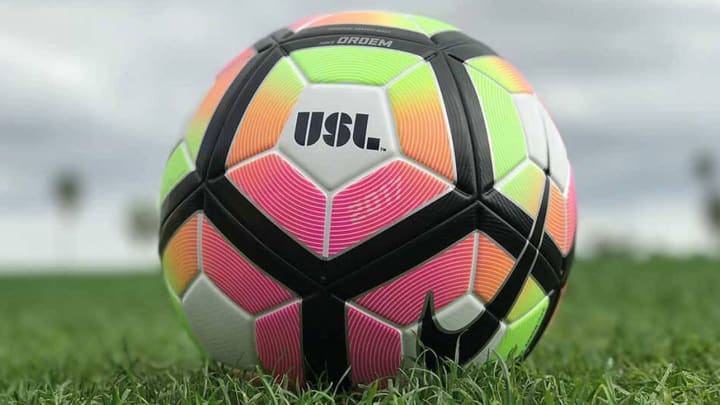USL will launch second league in 2019 to occupy U.S. Soccer's Division 3

The United Soccer League and its ever-expanding roster of clubs spent around two years, a lot of effort and a lot of money to build a circuit worthy of second-division sanctioning. And they received it—finally, but provisionally—in January. So now, after all that, the Tampa-based organization is once again eyeing division three.
The USL, which kicked off its 2017 season last weekend as one of the country’s two D2 leagues (the incumbent NASL is the other), is on the verge of revealing its intention to launch a new D3 competition in 2019, SI.com understands. An announcement could come before the end of this week.
The new league, the name of which is unknown, will fill the void left in the American third tier by the USL’s recent promotion to D2. This year will be the first since 1994 when there will be no recognized D3 championship. MLS kicked off in 1996 at the top of the pyramid and since then, there’s been considerable upheaval further down.
MLS expansion: An in-depth look at the many bids for the league's next four clubs
The A-League, whose D2 predecessors began play in the mid-1980s, was absorbed by the USL in 1997. From that point through 2009, it organized pro soccer in the USA and Canada at both the D2 and D3 levels. Then the second-tier split, the Federation took over for a season and in 2011, the NASL launched as D2 and the USL settled for D3. Six years later, the USL’s rapid rise—fueled by its affiliation with MLS—and uncertainty in the NASL have resulted in today’s crowded second tier and empty third.
But the USL apparently believes there are owners and cities eager to fill that space. U.S. Soccer’s pro divisions are defined by standards established by the Federation, and those for the third and lowest level obviously are the most forgiving. Only eight clubs are required and stadiums must have a minimum of just 1,000 seats (compared to 5,000 for D2). The lead owner (35%) of a D3 team must have an individual net worth of at least $10 million. Second-division owners need to be worth twice as much. At the D2 level, three-quarters of the clubs must play in metro areas with populations of 750,000 are more. There are no such requirements for D3.
There are, however, 75 U.S. cities with populations exceeding 750,000 and 107 with at least 500,000. MLS, the NASL and USL have a combined 60 teams, some of which share owners and/or markets. That means there’s plenty of room for the sport to expand.
The location and identity of the new D3 league’s founding clubs is unknown, but SI.com understands that the USL hopes to have those nailed down by the end of this year. The D3 schedule likely will be regionalized in order to cut down on travel costs. Some 2019 entrants may be expansion teams created by new ownership groups and others could come from the PDL or NPSL, the two nationwide semipro/amateur leagues. The PDL is a USL subsidiary, so transition for interested clubs should be relatively seamless, and several PDL teams are professionally run and attract decent crowds.
Landon Donovan finds his post-playing passion in San Diego's MLS expansion bid
Another possibility—and this is speculation—is that MLS owners who would rather not spend the money required to maintain reserve teams at a D2 standard might seek to drop those sides to the new D3 league. It’s unknown whether MLS would allow it, but it might make sense for squads that are designed to develop players, not draw crowds. One of the reasons for the USL’s provisional D2 sanctioning is that a couple MLS reserve teams were forced to upgrade their stadiums.
A far more intriguing possibility is an eventual system of promotion and relegation between the USL's D2 and D3 leagues. A lot will have to happen to make it happen, but the potential exists–at least theoretically–since both circuits will be under the USL's control. That isn't lost on the league's owners and executives. But many of the familiar hurdles will remain, from sanctioning standards to the difference in investment (and the nature of stadium and sponsorship contracts, etc.) between D2 and D3 clubs. It remains to be seen whether the USL's D3 league will evolve into something that might provide reasonable competition for a relegated D2 side. Either way, such a scheme is much further down the road.
It’s believed that there are no current independent USL teams eyeing a move to D3. And there remains no indication that the two D2 leagues intend to create any sort of unified competition, schedule or structure at the present time. The NASL now has eight members and must add four additional clubs in order to meet U.S. Soccer’s D2 standards in 2018.
Promotion and relegation in the USA? Sunil Gulati on why it's not in place
None of this is foreign territory for the USL, which is accustomed to operating at the third tier and spent 13 years running D2 and D3 leagues simultaneously. There was far too much franchise fluctuation in the old days, however, and the current USL managed to secure D2 status due in large part to its more careful pursuit of increasingly reliable owners and markets (MLS obviously helped in that regard). That formula appears to have worked.
The USL comprised just 11 members as recently as 2012. It now boasts 30, including teams in Sacramento and Cincinnati that average five-figure crowds. Those two, along with owners and/or clubs in St. Louis, San Antonio, Phoenix and Tampa Bay, have applied to join MLS as part of the top-tier league’s planned expansion to 28.
The USL now seems prepared to leverage that stability and potential to attract investors at the base of America’s fluctuating pro pyramid.
